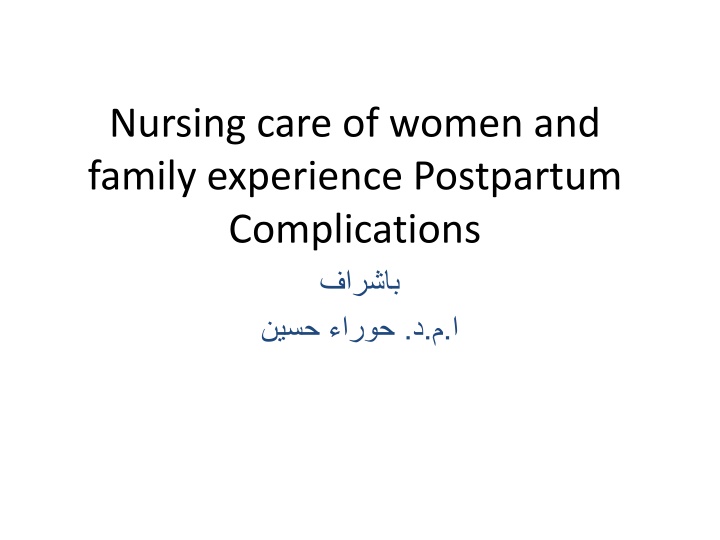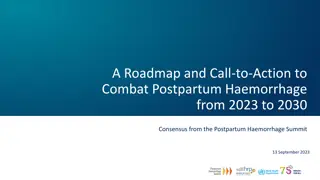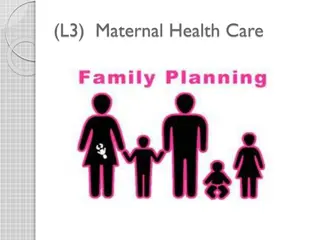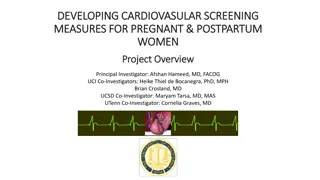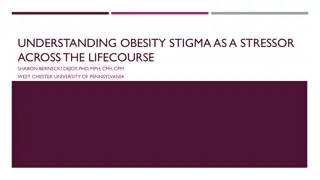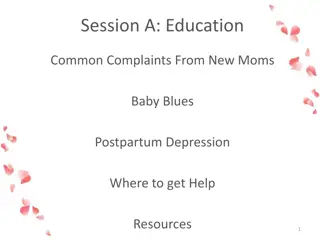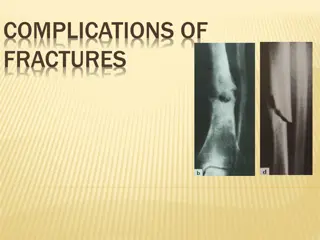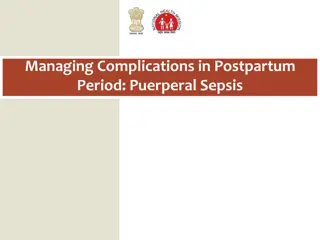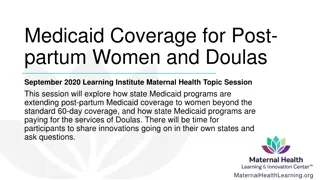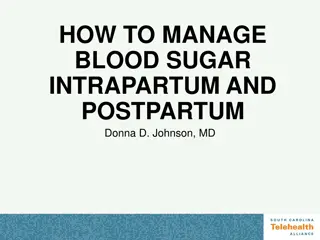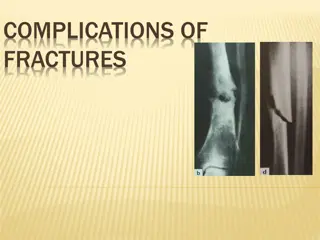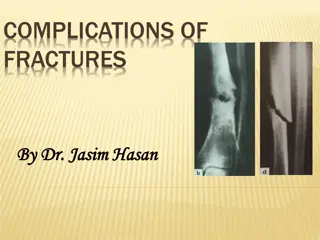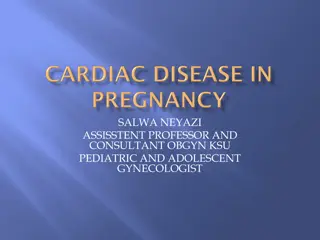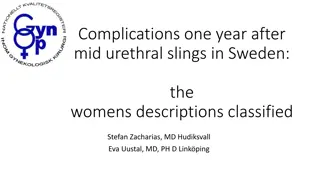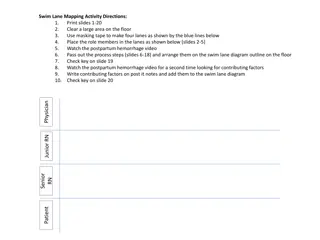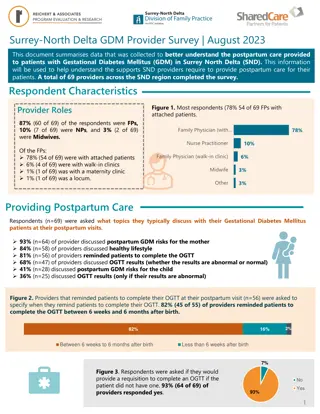Postpartum Complications: Understanding and Addressing
Postpartum hemorrhage, hypertensive disorders, infections, and other common complications. Learn about causes, risk factors, types, and assessment of postpartum issues like hemorrhage.
Download Presentation

Please find below an Image/Link to download the presentation.
The content on the website is provided AS IS for your information and personal use only. It may not be sold, licensed, or shared on other websites without obtaining consent from the author.If you encounter any issues during the download, it is possible that the publisher has removed the file from their server.
You are allowed to download the files provided on this website for personal or commercial use, subject to the condition that they are used lawfully. All files are the property of their respective owners.
The content on the website is provided AS IS for your information and personal use only. It may not be sold, licensed, or shared on other websites without obtaining consent from the author.
E N D
Presentation Transcript
Nursing care of women and family experience Postpartum Complications . . .
Common postpartum complications Postpartum hemorrhage Hypertensive disorders Infection Venous disorders Postpartum mood disorders Amniotic fluid embolism
Postpartum hemorrhage Definition: Blood loss >500cc within 24 hrs of delivery (vaginal delivery) Blood loss >1000cc within 24 hrs of delivery (Cesarean delivery) A change in postpartum hemoglobin concentration Blood loss requiring transfusion
Types of postpartum hemorrhage Primary or early postpartum hemorrhage Occurs within 24 hrs after delivery Secondary or delayed postpartum hemorrhage Occurs 24hrs to 12 wks after delivery More commonly due to placental site sub involution and retained placental parts May be associated with von Willebrand s disease
causes of postpartum hemorrhage Uterine atony Lacerations of the upper or lower genitourinary tracts Retained products of conception Invasive placental implantation Uterine inversion or rupture Coagulation disorders Infection Placental site subinvolution
Risk factors Precipitous or prolonged 1st or 2nd stage of labor or both Overstretching of the uterus Drugs Birth trauma Previous postpartum hemorrhage, uterine rupture or uterine surgery Past placenta accreta, increta or percreta Current diagnosis of placenta previa
Risk factors (cont Uterine malformation or fibroids Coagulation disorders Maternal exhaustion, malnutrition, anemia or PIH Grand multiparity Uterine infection
Assessment Symptoms: Dizziness, lightheadedness, fainting Tachycardia, tachypnea, weak pulse, decreasing bp Oliguria, profound hypotension and signs of shock Altered loc Uterine atony Lacerations Hematoma DIC (disseminted intervascular )
Intervention Immediate postpartum period Prompt response Medical orders Exam for lacerations Removal of retained products of conception Uterine tamponade Arterial embolization Surgery
Intervention (cont After initial post delivery period Uterine assessment Lochia assessment Vital signs Guard against inaccurate assessment Notify physician
After stabilization Encourage rest Nutritional and fluid support Vitamins and iron supplements Assist and encourage mild activity Antibiotics as ordered
Hypertensive disorders Five classifications of hypertension in pregnancy Gestational hypertension Preeclampsia Eclampsia Chronic hypertension Preeclampsia superimposed on chronic hypertension
Postpartum management of hypertension 30% of cases of eclampsia and HELLP syndrome occur after delivery Magnesium sulfate continued postpartum as ordered or per policy Facilitate family bonding Discharge teaching
Postpartum management of hypertension (cont) Monitor for signs and symptoms of preeclampsia Strict bp measurement Monitor renal function, liver function tests, platelet count and coagulation profile Medications Labetolol Hydralazine Nifedipine Continue treatment for 2-3 wks postpartum and then reevaluate
Infection Definition An oral temp > 100.4F on any two of the first ten days postpartum Temp 101.6F or higher during the first 24 hrs post delivery taken at least four times a day
Types of infections Endometritis Cesarean section wound infection Perineal wound infection Urinary tract infection Breast infection other ( upper respiratory infection or appendicitis or other viral infections)
Risk factors Cesarean birth Young age Low socioeconomic status Prolonged labor Multiple vaginal exams during labor Severe anemia or diabetes Traumatic delivery
Risk factors Postpartum hemorrhage Malnutrition Pre-existing infection Hematoma Foley catheter in place > 24 hrs Perineal lacerations Internal monitoring
Assessment Genital tract Urinary tract Breasts Wound Psychosocial
Interventions IV antibiotics Cultures Prevention Education
Venous disorders Definition: Variety of terms (superficial phlebitis, DVT (deep vein thrombophlebitis ), thrombophlebitis) Inflammation or infection of the wall of a vessel in which a clot attaches to a vessel wall with possible thrombus formation Incidence Decreased with early ambulation Dvt-more common in antepartum period Pe-more common in postpartum period Can occur up to the 20thday postpartum
Types of venous disorder Superficial phlebitis Deep vein thrombosis Septic pelvic thrombophlebitis
Causes of venous disorder Vessel wall damage Venous stasis Altered coagulation state
assessment Reports of pain in leg or groin Nonspecific back pain or right lower quadrant pain Tenderness to palpation Increased temperature of limb Coolness of limb with edema and pain Erythema or discoloration of the extremity Fever Pulmonary embolism Homans sign
Diagnostics D-dimer Ultrasound or MRI Complete blood count Blood cultures Screening for clotting disorders
Interventions Bedrest Elevation Analgesics Compression therapy Anticoagulants Heparin Coumadin Lovenox
Intervention Oxygen as needed Frequent rest periods Vital signs Emotional support
Postpartum mood disorders Baby blues Postpartum depression Postpartum psychosis
Postpartum mood disorders Baby blues Mildest form of pp mood disorder Occurs on the 3rdto 8thpp day Incidence of 60-80% of all pp women Symptoms disappear spontaneously by the second postpartum week with support and adequate rest May progress to postpartum depression
Postpartum mood disorders Postpartum depression Major mood disorder the onset of which occurs within the first 4 weeks after delivery Incidence 10-20% of all postpartum women Depressed mood or decreased interest or pleasure in activities, most of the day nearly every day for 2 weeks or more Disabling and can last for prolonged period
Postpartum mood disorders Postpartum psychosis Symptoms include hallucinations, bizarre behavior, delusions, extreme disorganizations of thought and phobias Incidence of 0.1% pr 1/1000 postpartum women Onset usually occurs within the first 2 weeks after delivery Women with postpartum psychosis should not be left alone with their infants
Assessment Risk factors Symptoms Physical findings Psychosocial findings Diagnostics
intervention Data collection Request psych evaluation Confirm correct use of antidepressant medications Support coping mechanisms Facilitate family interactions and care Explain changes that occur during postpartum period Assist with home risk identification
Amniotic fluid emboliss Also called anaphylactoid syndrome of pregnancy It is thought that the entry of amniotic fluid and fetal cells into the maternal circulation in certain patients causes an anaphylactiod reaction Causes acute onset of maternal dyspnea and hypotension, followed by cardiopulmonary collapse
Amniotic fluid embolism 40% develop, left-sided heart failure, and multisystem failure Mortality rate as high as 80% Those who survive 85-92% have permanent neurologic impairment
Assessment physical finding Acute respiratory distress Acute circulatory collapse Acute onset of coagulopathy Psychosocial findings Diagnostic possibilities
Intervention Recognition Oxygen and IV therapy CPR Assist with intubation Administer crystalloid solutions Monitor vital signs, pulse oximetry and color Have emergency medications at hand
Intervention (cont Obtain chest x-ray and ekg Observe for signs and symptoms of shock Observe for signs and symptoms of coagulopathy Obtain lab work Assist with central line placement Prevent hypothermia Keep family informed
Reference http://www.9news.com/story/news/health/2014/11/19 /amniotic- fluid-embolism-denver-mother/19250207/ Su, L, Chong, Y, Samuel, M. Carbetocin for preventing postpartum haemorrhage, Cochrane Database Syst Rev (Issue 4): DOI: 10.1002/14651858.CD005457.pub4. Chichester, UK: John Wiley & Sons; 2012. Tuncalp, O, Hofmeyr, GJ, G lmezoglu, AM. Prostaglandins for preventing postpartum haemorrhage, Cochrane Database Syst Rev (Issue 8):DOI: 10.1002/14651858.CD000494.pub4. Chichester, UK: John Wiley & Sons; 2012. Begley, CM, Gyte, GM, Devane, D, et al. Active versus expectant management for women in the third stage of labour, Cochrane Database Syst Rev (Issue 11): DOI: 10.1002/14651858.CD007412.pub3. Chichester, UK: John Wiley & Sons; 2011.
